Can Someone Hack Arlo Cameras
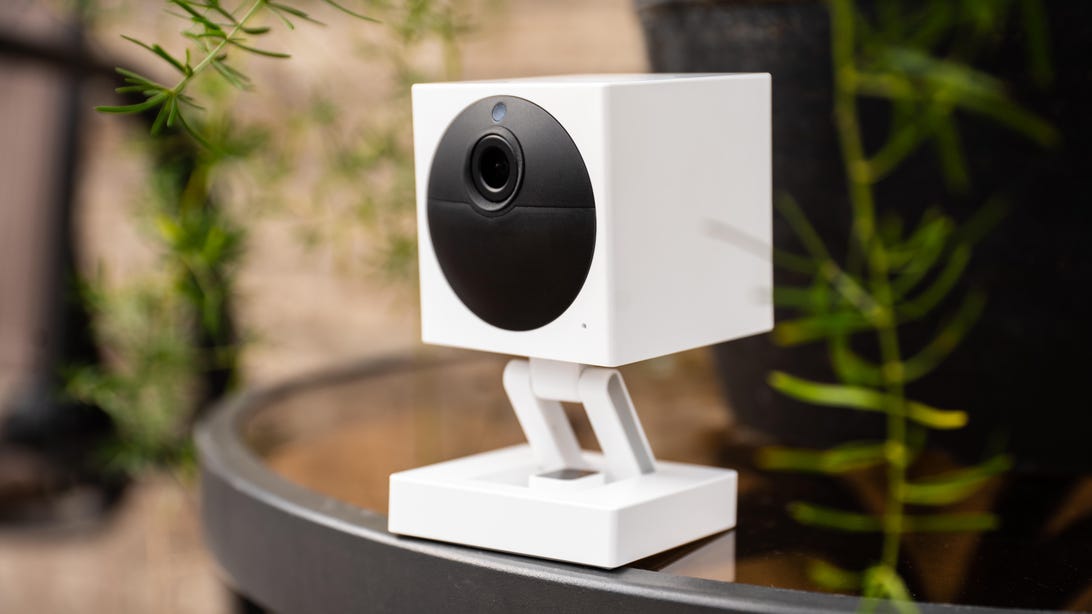
Here are a few practices that can aid protect your device security and data privacy.
Chris Monroe/CNETInstalling an net-continued security camera in your house won't necessarily bring a moving ridge of hackers to your Wi-Fi network -- but losing privacy resulting from a device's security shortcomings is surprisingly mutual. Last year, an ADT abode security customer noticed an unfamiliar email address connected to her dwelling security account, a professionally monitored arrangement that included cameras and other devices inside her home. That simple discovery, and her written report of it to the visitor, began to topple a long line of dominoes leading back to a technician who had spied, over the class of four and a half years, on hundreds of customers -- watching them live their private lives, undress and even have sexual practice.
ADT says information technology has closed the loopholes that technician exploited, implementing "new safeguards, preparation and policies to strengthen … business relationship security and customer privacy." But invasions of privacy are non unique to ADT, and some vulnerabilities are harder to safeguard than others.
Whether you're using professionally monitored security systems such as ADT, Comcast Xfinity or Vivint, or you just have a few stand-lone cameras from off-the-shelf companies similar Ring, Nest or Arlo, hither are a few practices that can aid protect your device security and data privacy.
Read more: Amazon unwraps privacy features as it tries to curl deeper into your habitation
Is my security system vulnerable?
Before jumping into solving the problems of device insecurity, information technology's helpful to sympathise how vulnerable your devices actually are.
Major professionally monitored security systems -- and even individually sold cameras from reputable developers like Google Nest and Wyze -- include high-stop encryption (which scrambles messages within a system and grants admission through keys) almost across the board. That means every bit long as you lot stay current with app and device updates, you should have little to fear of being hacked via software or firmware vulnerabilities.
Too, many security companies that employ professional installers and technicians accept strict procedures in identify to avoid precisely what happened at ADT. The Security Industry Association -- a third-party group of security experts -- advises manufacturers such as ADT on matters relating to privacy and security.
"The security manufacture has been paying attending to [the issue of privacy in the habitation] since 2010," said Kathleen Carroll, chair of the SIA's Information Privacy Informational Lath, "and we proceed to work to assist our member companies protect their customers."
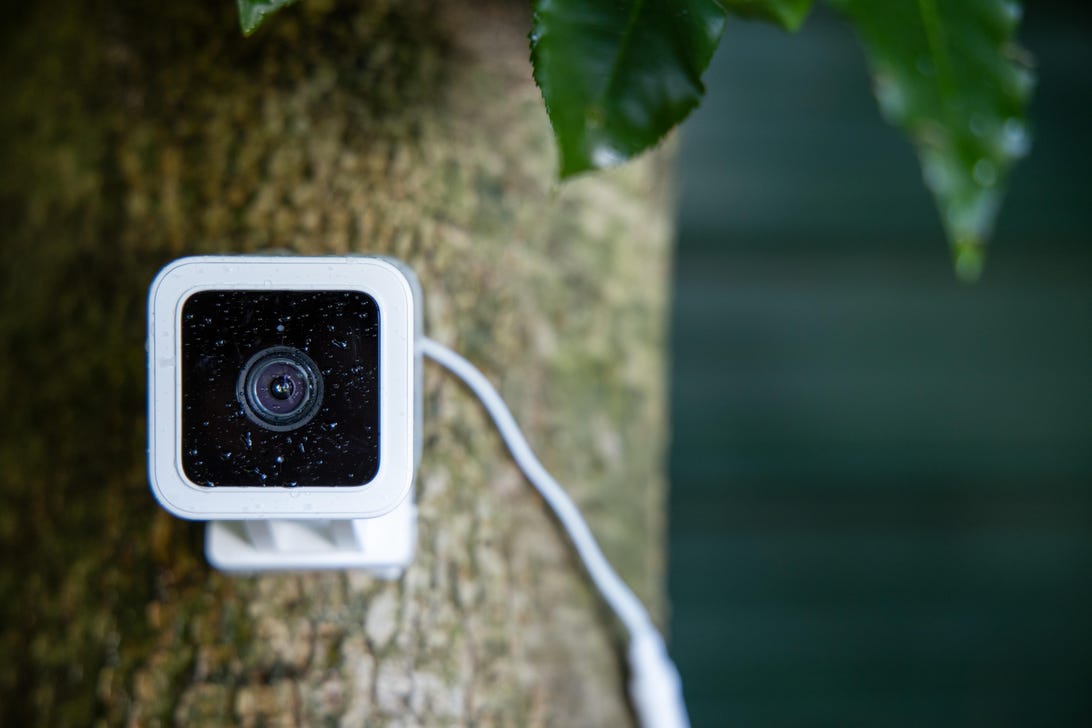
Security cameras are getting cheaper by the year, but that doesn't mean customers should be comfortable giving upward their privacy.
WyzeSome professionally monitored systems, such every bit Comcast and now ADT, address the trouble by simply strictly limiting the deportment technicians tin have while assisting customers with their accounts -- for instance disallowing them from adding email addresses to accounts or accessing any recorded clips.
"We have a team at Comcast dedicated specifically to photographic camera security," a Comcast spokesperson said. "Our technicians and installers have no access to our customers' video feeds or recorded video, which can merely be accessed past a small group of engineers, under monitored conditions, for bug like technical troubleshooting."
"Merely customers can decide who is allowed to access their Vivint system, including their video feeds," a spokesperson for home security company Vivint said. "Equally admin users, they tin add, remove or edit user settings. And ... we regularly conduct a variety of automated and manual audits of our systems."
With DIY systems, customers set upward their ain devices, making technician access a moot betoken. But if customers opt into additional monitoring, which is often offered alongside individual products, that may complicate the outcome.
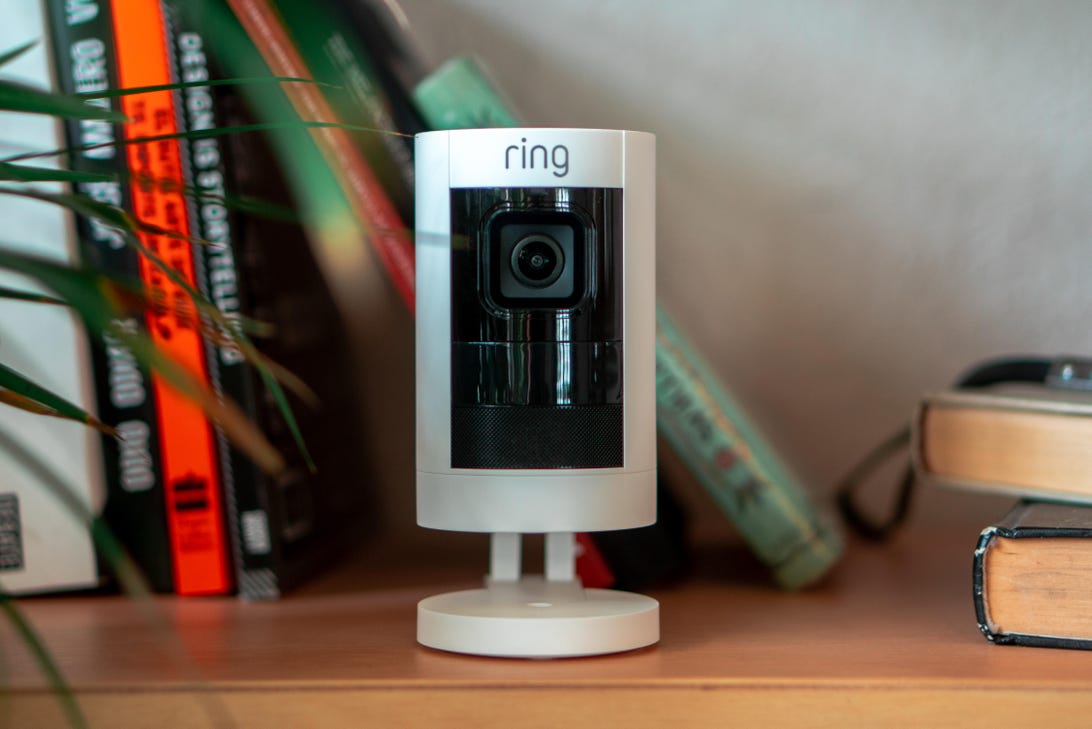
More cameras are available to buy than ever before, whether you're opting into a professionally monitored security system or a DIY alternative.
Óscar Gutiérrez/CNETOne such company, Frontpoint, said in an e-mail that information technology tightly constrains personnel admission to customer data, disallowing, for instance, agents from watching client camera feeds -- except in detail, time-boxed cases where permissions are obtained from the customer, for the purpose of troubleshooting or other types of assistance.
A representative of SimpliSafe, some other developer straddling the line between DIY and professionally installed home security, responded more broadly to questions about its procedures: "Much of our mean solar day-to-solar day work is focused on maintaining our systems and so that vulnerabilities are immediately identified and addressed. This relentless focus includes both internal and external security protocols."
In short, security companies appear to be consciously using multiple levels of security to protect customers from potential abuse by installers and technicians -- fifty-fifty if the processes by which they exercise this aren't entirely transparent. But even if they're effective, that doesn't hateful your smart cameras are totally secure.
How could my cameras exist accessed?
The ADT case didn't technically crave any hacking on the part of the technician, but what if hacking is involved? There are plenty of cases of remote hacks, afterward all. And even quality devices with high levels of encryption aren't necessarily condom from hacking, given the right circumstances.
At that place are two primary ways a hacker can gain control of a video feed, security expert Aamir Lakhani of FortiGuard told CNET: locally and remotely.
To access a camera locally, a hacker needs to be in range of the wireless network the camera is connected to. There, they would need to obtain access to the wireless network using a number of methods, such as guessing the security passphrase with brute forcefulness or spoofing the wireless network and jamming the actual i.
Within a local network, some older security cameras aren't encrypted or password-protected, since the wireless network security itself is ofttimes considered enough of a deterrent to keep malicious attacks at bay. So once on the network, a hacker would have to practise little else to take control of the cameras and potentially other IoT devices effectually your house.
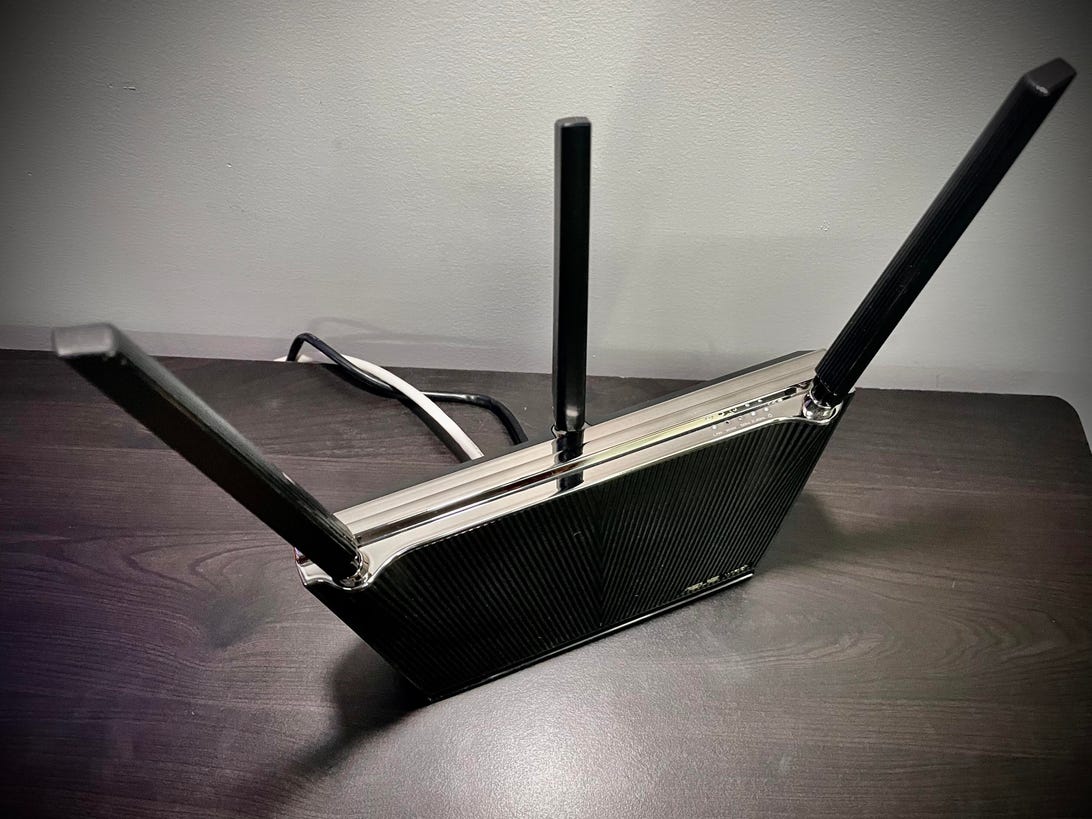
Hacking routers directly and locally is one road, albeit an uncommon 1, to admission a security photographic camera feed.
Ry Crist/CNETLocal hacks are unlikely to touch you, though, every bit they require focused intent on the target. Remote hacks are the far more likely scenario, and examples crop upward fairly often in the news cycle. Something as mutual equally a data breach -- such as those at Equifax or Delta -- could put your login credentials in the incorrect easily, and short of changing your password frequently, there's not much you could exercise to prevent it from happening.
Even if the security company yous use -- professionally monitored or otherwise -- has potent security and end-to-end encryption, if you use the same passwords for your accounts as you do elsewhere on the internet and those credentials are compromised, your privacy is at risk.
And if the devices you lot use are dated, running out-of-engagement software or simply products from manufacturers that don't prioritize security, the chances of your privacy being jeopardized rise significantly.
For hackers with a piddling know-how, finding the side by side target with an unsecured video feed is only a Google search away. A surprising number of people and businesses prepare up security camera systems and never alter the default username and countersign. Certain websites, such every bit Shodan.io, display but how easy it is to access unsecured video feeds such as these by aggregating and displaying them for all to run into.
How to know if you've been hacked
It would be well-nigh impossible to know if your security photographic camera -- or perhaps more unnervingly, baby monitor -- has been hacked. Attacks could get completely unnoticed to an untrained centre and almost people wouldn't know where to brainstorm to wait to cheque.
A red flag for some malicious activity on a security photographic camera is slow or worse than normal performance. "Many cameras have express retentivity, and when attackers leverage the cameras, CPU cycles have to piece of work extra difficult, making regular camera operations near or entirely unusable at times," said Lakhani.
Then again, poor operation isn't solely indicative of a malicious attack -- it could have a perfectly normal explanation, such as a poor internet connection or wireless signal.
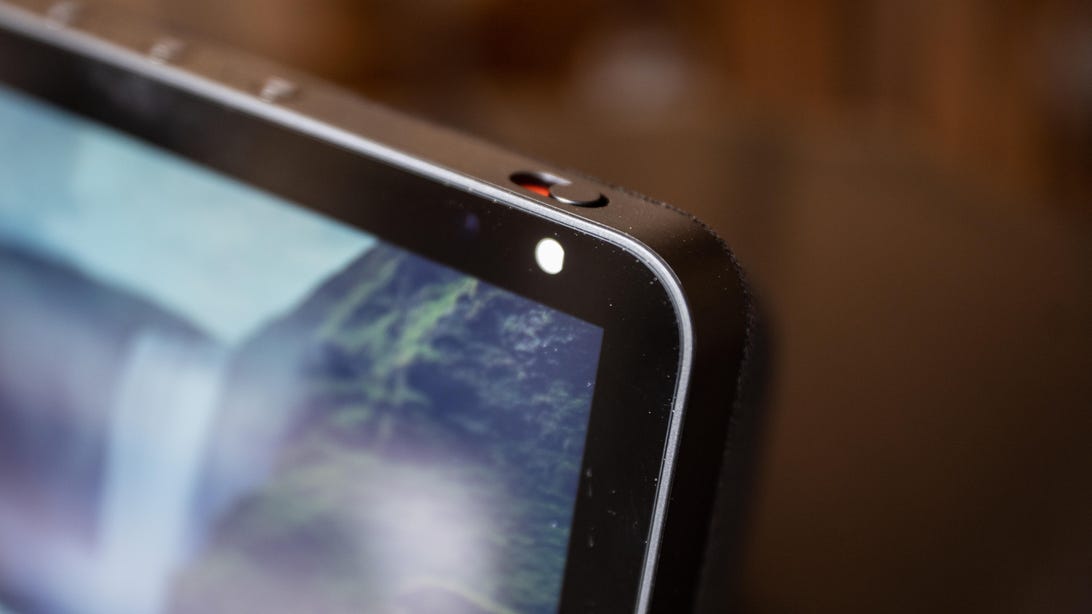
Some devices, such as Amazon'due south newer Repeat Show displays, feature concrete shutters to embrace cameras when they are not in use.
Chris Monroe/CNETHow to protect your privacy
While no one system is impervious to an attack, some precautions can farther subtract your odds of existence hacked and protect your privacy in the instance of a hack.
- Use cameras from reputable manufacturers, whether they are part of a professionally monitored security system or a DIY device.
- Use cameras with loftier-level, cease-to-end encryption.
- Change your credentials to something that cannot easily be guessed (in particular, avoid using passwords you already use for other online accounts).
- Update the camera firmware frequently or whenever possible.
- Utilize two-cistron hallmark if possible.
Some other important step is but avoiding the weather condition for an invasion of privacy. Hacks are unlikely and can be largely avoided, but keeping cameras out of private rooms and pointed instead toward entryways into the house is a skillful way to avert the worst potential outcomes of a hack.
Lakhani also suggested putting stand-alone security cameras on a network of their own. While this would doubtless foil your plans for the perfect smart home, it would help prevent "state and aggrandize," a process past which an attacker gains access to one device and uses it to take control of other connected devices on the aforementioned network.
Taking that one step further, you lot tin can utilise a virtual private network, or VPN, to further restrict which devices tin access the network the security cameras are on. You tin also log all activity on the network and be certain there's zip unusual happening there.
Again, the chances of beingness the victim of an assail like this are quite modest, especially if yous follow the almost basic safe precautions. Using the higher up steps will provide multiple layers of security, making it increasingly difficult for an attacker to take over.
Correction, Feb. xi: An before version of this article misstated when ADT sought advice from the SIA. ADT's work with the SIA predates the discovery of the technician'due south corruption concluding yr.
More home security recommendations:
- Best video doorbell cameras
- Best home security systems
- Best wireless home security cameras
- Best facial recognition cameras
- Best smart locks
- Best outdoor domicile security cameras
- All-time inexpensive home security cameras
- Best indoor habitation security cameras
Source: https://www.cnet.com/home/security/stop-home-security-camera-hacking/
Posted by: johnsonsefuldsider1981.blogspot.com


0 Response to "Can Someone Hack Arlo Cameras"
Post a Comment